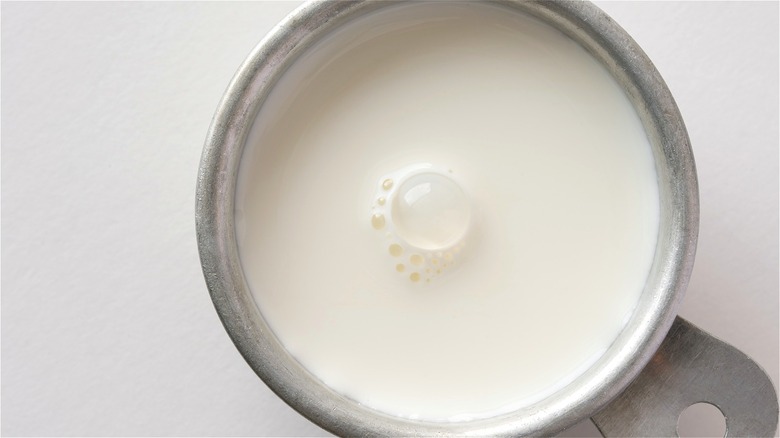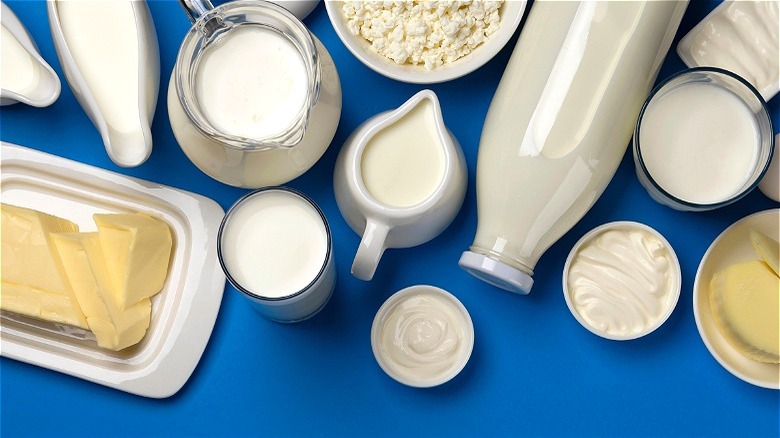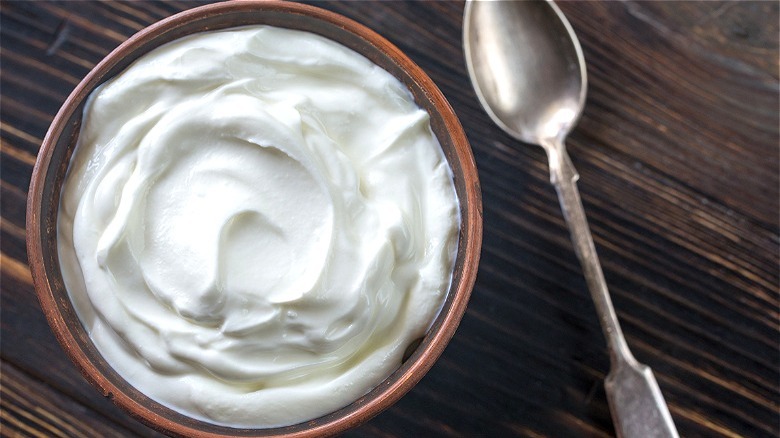The Perfect High-Protein Swap For Heavy Cream
For dairy consumers, next to butter, there aren't many recipe conundrums heavy cream can't also fix. Not to be confused with whipping cream, which only has 30% fat, and half-and-half, which is a mixture of cream and milk, What's Cooking America defines heavy cream or heavy whipping cream as the thick, fatty substance that has risen to the top of non-homogenized milk. Heavy cream is the richest option out there, containing no less than 36% fat.
Food Network points to the benefits of using heavy cream in your kitchen. The thick liquid is often used as an essential ingredient in homemade ice cream or as a thickener in soups and creamy pasta recipes. Heavy cream also stands tall on its own as a whipped accompaniment to your favorite apple pie.
However, there are some people who shy away from the rich, milky substance. First off, Boston Children's Hospital notes that up to 50% of Americans experience some form of lactose intolerance. Beyond that, heavy cream is also high in fat. While heavy cream contains many fat-soluble vitamins, including A and E, Healthline notes that this rich liquid is mostly saturated fat; a half cup contains roughly 400 calories and 43 grams of fat. If you're on the hunt for a better-for-you alternative, there's one swap that can provide you with a considerable amount of protein.
A better-for-you alternative to heavy cream
If you happen to be lactose intolerant, you have a few options if you're wanting to add a similar velvety component to your favorite dishes. Healthline suggests using coconut cream or a combination of silken tofu and soy milk blended together. Both can be whipped (just like heavy cream) and added to any after-dinner treat. For recipes like creamy tomato basil soup, which calls for 1 cup of heavy cream, The Pioneer Woman suggests mixing soy milk with half the amount of olive oil to achieve a comparable consistency.
If you eat dairy without tummy troubles, besides the mixtures of milk and cornstarch or milk and butter, Epicurious suggests using Greek yogurt for its attributing health benefits. BBC Good Food defines Greek yogurt as a sharper-tasting, thicker yogurt due to the removal of whey. To use Greek yogurt as an effective substitute, simply mix the yogurt with your milk of choice on a 1:1 ratio. Unfortunately, Greek yogurt can't be whipped like heavy cream, but with the addition of honey or your favorite sweetener, serves as a nice element to any rich confection.
Even though there are plenty of other alternatives to heavy cream, Greek yogurt may stand apart for its additional health properties. And, surprisingly, this high-protein ingredient acts as an effective substitute for more than just heavy cream.
Substitute Greek yogurt for other foods
According to the University of Tennessee Medical Center, one six-ounce container of Greek yogurt typically holds up to 20 grams of protein and contains far less sodium than traditional yogurt. While Greek yogurt does have slightly less calcium than one of the traditional varieties, it still serves as a great stand-in for many ingredients apart from heavy cream.
Besides functioning as an essential component of better-for-you strawberry shortcakes, people can use Greek yogurt for many other popular condiments and dairy products. Undeniably Dairy breaks down the exact measurement alternatives when using Greek yogurt as a substitution for particular foods such as mayonnaise, butter, cream cheese, and oil.
Once you know how to substitute Greek yogurt appropriately, you can swap it for the sour cream in Martha Stewart's green goddess dressing and even use it as a marinade in Bobby Flay's mint and yogurt marinated leg of lamb (via Food Network). Greek yogurt is a great alternative to a number of high-fat condiments and dairy products in addition to everyone's favorite heavy cream.


